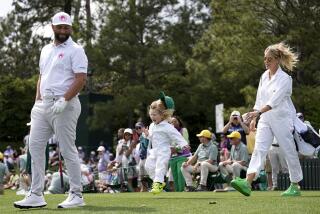Shades of Opinion : Sunglasses Part of Golf’s New Look, but Purists Take Dim View
- Share via
It’s paradoxical, really.
Most golfers will spend a small fortune on anything that might help improve their score. Graphite-shafted drivers that cost $250. Custom-made clubs of questionable merit marketed on TV infomercials.
Mid-sized irons.
Undersized bags.
Oversized price tags.
Clubs forged of composite aluminum, steel, beryllium, graphite or titanium. Everything but Kryptonite.
Those marketing pricey wares always have an eye on the future and, it seems, the eyes of top players soon will be covered by sunglasses costing upward of $150 a pair.
Weekend hacks, of course, have worn shades for years. However, the game’s best players steadfastly have refused for a variety of dubious reasons.
“I can’t drive my car without them,” said Craig Steinberg, an optometrist and one of the Southland’s best amateurs.
Yet he won’t drive a ball with them. Steinberg, a three-time winner of the Southern California Golf Assn. Amateur championship, said he hasn’t worn shades while playing for two reasons:
* He believes the coloring of the lens negatively affects his ability to read the texture and grain of greens as well as the consistency of sand in bunkers.
* He can see the eyeglass frame in his peripheral vision as he swings the club, a major distraction.
Another major reason, of course, is sheer obstinacy. Golf is steeped in tradition, perhaps more than any sport other than baseball. Sunglasses have existed for decades, yet no top player worth his salt would have been caught dead wearing a pair until recently. It was heresy. Fuzzy Zoeller is one of a handful of PGA Tour regulars who now wear sunglasses while playing.
Dozens of top players excelled for years while wearing prescription lenses--Hale Irwin, for instance--and lived to talk about it. Shades are another story.
“Nobody would have dreamed of wearing sunglasses when Jack Nicklaus was 20 years old,” said Steinberg, who lives in Van Nuys. “It wasn’t part of the dress, part of the uniform.”
As usual, the youngsters are changing the sartorial rules. At the SCGA Amateur championship last weekend in La Habra Heights, several college hot-shots wore sunglasses while competing. The old guard squinted along, as usual.
In the college ranks, dozens of top players swear by their wraparound shades. They’ve become de rigueur in the NCAA ranks.
“I can’t play without them now,” said Jason Gore of Valencia, a two-time Pacific 10 Conference champion from Arizona. “When I take them off, I get a headache.”
Gore said despite the presence of a condition that often causes considerable discomfort when his eyes are exposed to the sun, he never wore shades until last spring. Few top players did, so he didn’t, either.
Robert Gamez, who played at Arizona and wears sunglasses while competing on the PGA Tour, donated several pairs to his alma mater. Players swept them up and quickly became converts. How much does Gore like his sunglasses? He now wears three pairs tinted in various hues.
Gore wears contact lenses and says the shades keep wind-blown irritants out of his eyes. What’s more, Gore believes his wraparound lenses help, not hinder, his ability to read greens.
“I feel you can read a green better if you’re not squinting,” said Gore, who finished ninth at the SCGA Amateur. “You get a better look.”
Chad Wright of Ventura, a sophomore at USC, also wears sunglasses while playing. College events often require 36 holes a day, which can result in severe eye irritation and fatigue.
Like Gore, Wright started wearing sunglasses in the spring and already swears by them.
“I never thought I’d wear them,” Wright said. “It was just something golfers don’t do. But these are so comfortable, I don’t even notice I have them on.”
Practicality aside, the medical benefits of shades are even more significant. Steinberg said recent clinical studies have found a link between bright sunlight and cataract growth.
“Some of this is just coming to light--no pun intended,” Steinberg said.
Steinberg said a good pair of sunglasses filters out certain bands of light that can cause harm to the eyes or cause vision to be blurred. Acuity increases and distortion virtually disappears. So far, so good, right?
That said, it should be noted that Steinberg, 36, wears neither a hat nor sunglasses. But that doesn’t mean he doesn’t appreciate the risks involved. He simply hasn’t been able to make the adjustment to wearing shades after all these years. Perhaps younger players can make the transition easier.
“There’s room for personal judgment,” he said. “Guys on the Senior PGA Tour wear wide-brimmed hats because they’re old enough to appreciate the skin-cancer risks. Musicians are wearing earplugs because the Rolling Stones or whoever are all deaf now.”
Santa Barbara’s John Pate, 34, is a top amateur who finished in a tie for fourth at the SCGA while wearing sunglasses. His brother, Steve, has made a small fortune on the PGA Tour and does not. Canoga Park’s Don Baker, 43, tied Pate for fourth and wore shades between shots.
In short, stoic members of the old school can be slow to accept change--especially if nobody is leading the charge. Once a few top players slide into a pair of snazzy frames, though, watch the frenzy begin.
“People might think it looks funny,” Wright said. “Pretty soon, I think people on tour will start wearing them.”
Then again. . . .
“My experience has been that if you gave somebody two shots off their average and cancer,” Steinberg said, “They’d still take the two shots.”
More to Read
Go beyond the scoreboard
Get the latest on L.A.'s teams in the daily Sports Report newsletter.
You may occasionally receive promotional content from the Los Angeles Times.










